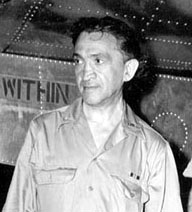I've written often about the famed NY Times reporter known as "Atomic Bill"--that would be W.L. Laurence, who was embedded in the Manhattan Project, went along on the bombing run over Nagasaki, and in general glorified the creation and use of the atomic bomb, and covered up its true dangers, as the most influential reporter in this area for years.
But today marks the 75th anniversary of the first atomic test, at Trinity, which he revealed only after the Hiroshima blast, and then downplaying the radiation dangers here at home. As I've written: "Here was the nation’s leading science reporter, severely compromised, not only unable but disinclined to reveal all he knew about the potential hazards of the most important scientific discovery of his time."
A key moment came a month later when, with a few other reporters, he was taken by General Leslie Groves, head of the Manhattan Project, to the crater created by the Trinity blast. His report in the Times would again pooh-pooh radiation effects. Soon a young soldier sent into the crater would die. Here is my recent article, with excerpt below. And my new book covers the test and cover-up and much more in that vein, The Beginning or the End: How Hollywood--and America--Learned to Stop Worrying and Love the Bomb.
*****
On September 9, 1945, Laurence toured the Trinity test site, in New Mexico,
where the United States tested its first atomic weapon on July 16, with General
Leslie Groves and physicist J. Robert Oppenheimer. The top-secret area finally
had been opened to journalists.
Two weeks earlier, President Truman’s secretary, Charles G. Ross, had sent a
memo to the War Department urging the military to recruit a group of reporters
to explore the test site. "This might be a good thing to do in view of
continuing propaganda from Japan," Ross wrote.
Now General Groves, who believed the reports of radiation disease from Japan
were a “hoax,” was personally escorting some of the newsmen near ground
zero. His driver, a young soldier named Patrick Stout, spent several minutes
in the crater of the blast and was photographed, smiling.
Laurence’s account of this visit (delayed three days until September 12
due to a censorship review) disclosed quite frankly why he and thirty other
journalists had been invited: to "give lie to" Japanese “propaganda”
that ” radiations were responsible for deaths even after" the Hiroshima
attack, as he wrote. He quoted General Groves calling any deaths
by radiation in Japan as “very small.” (In truth, the total was probably 20,000
or more in the two bombed cities.)
General Groves had expressly asked the reporters to assist him in this effort,
and they did not disappoint him. (He was also in the process of securing script
approval on that MGM movie about the bomb.) Geiger counters showed that surface
radiation, after nearly two months, had "dwindled to a minute quantity,
safe for continuous human habitation," Laurence asserted. He did introduce
one bit of contrary information: the reporters had been advised to wear canvas
overshoes to protect against radiation burns.
The press tour, in fact, had "an oddly reassuring effect," the New
York Times observed in an editorial. Still, a scientist informed the
young soldier, Patrick Stout, who stood in the crater during the press tour,
that he had been exposed to dangerous levels of radioactivity. Twenty-two years
later Stout became ill and was diagnosed with leukemia. The military, apparently
acknowledging radiation as the cause, granted him "service-connected"
disability compensation. Stout died in 1969.

1 comment:
You have the most provocative blog I've seen. I'd comment often if I wasn't such a robot.
Post a Comment